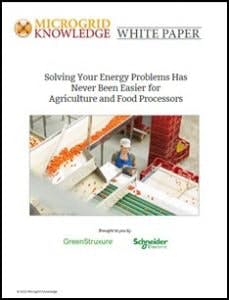Farmers, food processors and operators in the agriculture space are increasingly challenged by energy problems like higher energy costs, electric reliability issues and the need to cut greenhouse gas emissions. According to a white paper from GreenStruxure, they’re looking for new on-site energy options that can turn these challenges into opportunities. Chief among these potential solutions are microgrids.
The author explains that “a microgrid is a self-sufficient energy system that serves a discrete geographic footprint, such as a college campus, hospital complex, business center, farm or food processing plant.” The white paper outlines four ways in which this technology can benefit agricultural operations, food processors and others along the food supply chain. First, agricultural microgrids offer resilience through increased electric reliability. Using examples from California, the author notes that “microgrids can step in when the grid is out to maintain critical operations, thus avoiding potentially costly product losses, decreases in the value of a product or process disruptions.”
Second, when powered by renewable energy sources such as solar, microgrids reduce greenhouse gas emissions. This makes it easier for agriculture businesses to meet the sustainability goals they’ve set or that the state has mandated.
“Owning a microgrid can lead to lower total costs of electricity over the system’s lifetime compared to buying power from the grid.” — GreenStruxure, “Solving Your Energy Problems Has Never Been Easier for Agriculture and Food Processors“
Third, agricultural microgrids provide cost-effective and predictable energy and operational costs. As the price of grid power continues to climb, it’s challenging to forecast energy and, ultimately, operational costs. Energy-as-a-service microgrids provide electricity at a guaranteed rate for the term of the contract, making energy costs predictable.
Finally, microgrids allow an organization to improve operations and grow its business through the electrification of formerly manual operations. GreenStruxure notes that “for food processors, microgrids can help scale-up operations or create modularity in production.”
The white paper also outlines the three primary microgrid business models that agricultural operators and food processors should consider when making a microgrid decision: ownership, leasing and energy-as-a-service. Download the paper for free from the Microgrid Knowledge white paper library.








